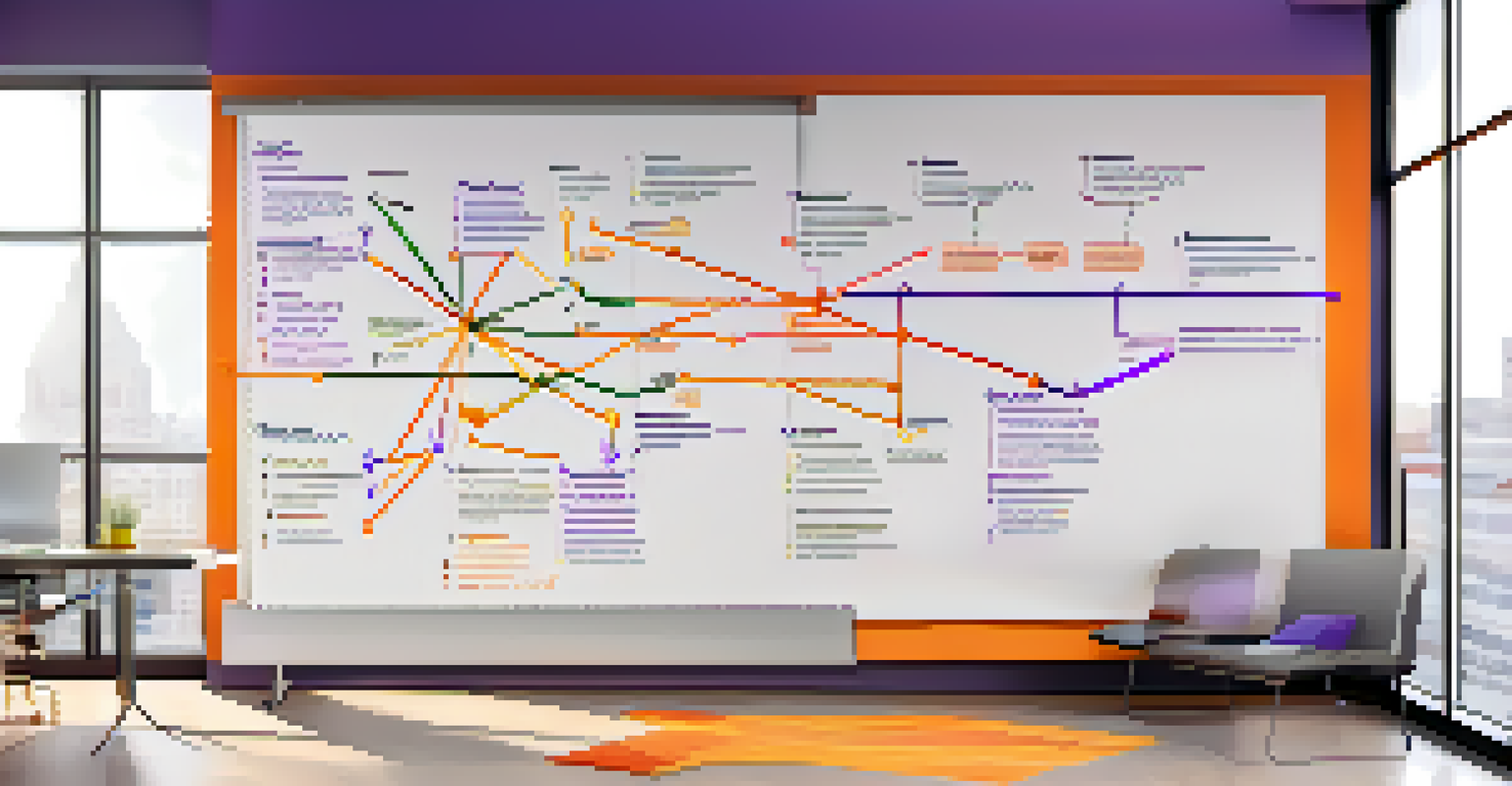Using Mind Mapping for Effective Career Goal Visualization

Understanding Mind Mapping: A Creative Tool for Visualization
Mind mapping is a visual thinking tool that helps you organize ideas. It involves creating a diagram that represents concepts, tasks, or goals branching out from a central idea. By using colors, images, and keywords, mind maps can spark creativity and enhance memory, making them ideal for visual learners.
The greatest danger in times of turbulence is not the turbulence; it is to act with yesterday's logic.
When it comes to career goals, mind mapping allows you to break down your aspirations into manageable pieces. For example, if your goal is to become a marketing manager, you can branch out into skills needed, potential employers, and networking opportunities. This structured approach gives clarity to your vision and highlights the steps you need to take.
Moreover, mind maps can be as simple or as elaborate as you wish, making them accessible to everyone. Whether you prefer a digital tool or a classic pen-and-paper method, the flexibility of mind mapping caters to your personal preferences, ensuring that your career planning is both enjoyable and effective.
Setting Clear Career Goals with Mind Mapping
The first step in using mind mapping for career visualization is to identify your ultimate career goal. This could range from landing a specific job to achieving a particular role within your industry. Having a clear main goal helps you focus your efforts and creates a foundation for your mind map.

Once you have your central goal defined, you can start branching out into smaller, actionable objectives. For instance, if your goal is to transition into tech, you might include branches for learning programming languages, attending workshops, or connecting with industry professionals. This breakdown ensures that your path is clear and manageable.
Mind Mapping Enhances Career Clarity
Using mind maps allows you to break down career goals into manageable pieces, providing clarity and a structured approach to achieving your aspirations.
In addition, regularly revisiting and updating your mind map is essential to track your progress. This iterative process not only keeps you motivated but also allows you to adapt your goals as your career evolves, ensuring that your map remains relevant to your aspirations.
Incorporating Personal Values into Your Mind Map
Personal values play a significant role in shaping your career goals. When creating your mind map, it’s vital to include elements that resonate with who you are. For example, if you value flexibility and creativity, ensure your career aspirations reflect that.
You cannot change your future, but you can change your habits, and surely your habits will change your future.
You can create branches in your mind map that focus on values such as work-life balance, company culture, or ethical considerations. This not only adds depth to your planning but also helps you visualize career paths that align with your core beliefs, making your pursuit more fulfilling.
By integrating your values into your mind mapping process, you can make informed decisions that lead to greater satisfaction in your career. This alignment fosters a sense of purpose and motivation, ensuring that your journey is not just about climbing the corporate ladder but also about personal growth.
Visualizing Skills and Qualifications Needed for Your Goals
With your career goals and values in mind, the next step is to visualize the skills and qualifications required to reach these aspirations. This can be done by creating branches that list necessary skills, certifications, and experiences. For instance, if you aim to be a data analyst, you might include data visualization tools and statistical analysis as key skills.
Mind mapping helps you see the bigger picture and identify gaps in your current skill set. By visually organizing this information, you can prioritize which skills to develop first, making your career advancement strategic and focused. This approach ensures you are well-prepared for the opportunities that come your way.
Incorporate Personal Values
Integrating personal values into your mind map ensures that your career goals align with what truly matters to you, fostering a more fulfilling journey.
Moreover, you can also branch out to include resources for acquiring these skills, such as online courses, books, or mentorship opportunities. This not only enhances your roadmap but also empowers you to take actionable steps toward achieving your career goals.
Creating a Timeline for Achieving Your Career Goals
A mind map can also serve as a timeline for your career goals. By adding timeframes to your branches, you can visualize when you aim to achieve each objective. For instance, if you plan to complete a certification within six months, you can mark that clearly on your map.
This visual representation of time helps you stay organized and accountable. It encourages you to set realistic deadlines and review your progress regularly. Just as a map guides you on a road trip, your timeline helps navigate the journey toward your career aspirations.
Additionally, incorporating milestones into your mind map can boost motivation. Celebrate these milestones as you achieve them, reinforcing your commitment to your career path and making the process enjoyable.
Leveraging Mind Mapping for Networking Opportunities
Networking is a crucial aspect of career development, and mind mapping can enhance this process. You can create branches dedicated to networking opportunities, including events, industry contacts, and social media platforms. This visual layout helps you see who you need to connect with and how you can approach them.
By mapping out your networking strategy, you can identify key individuals who align with your career goals. For example, if you’re aiming to work in renewable energy, you might branch out to include professionals in that sector or relevant industry conferences. This targeted approach increases your chances of making valuable connections.
Regularly Review Your Mind Map
Periodic reviews and adaptations of your mind map keep it relevant to your evolving career aspirations and help you celebrate progress along the way.
Furthermore, consider adding follow-up tasks to your mind map after networking events, such as sending thank-you notes or scheduling coffee chats. This proactive attitude will help you build relationships that are not just beneficial but also genuine.
Reviewing and Adapting Your Mind Map for Career Growth
The final step in using mind mapping for career goal visualization is to regularly review and adapt your map. As you gain new experiences and insights, your career aspirations may evolve. Therefore, it’s essential to revisit your mind map periodically to ensure it reflects your current goals and values.
This ongoing process allows you to celebrate accomplishments and reassess any areas that may require more focus. Perhaps a new opportunity has sparked your interest, or you’ve discovered a passion you didn’t know you had. Adapting your mind map keeps you agile and ready to embrace change.

Ultimately, a mind map is a living document. By treating it as a dynamic tool rather than a static plan, you empower yourself to grow and thrive in your career journey. This flexibility fosters resilience, ensuring that you are always aligned with your true aspirations.